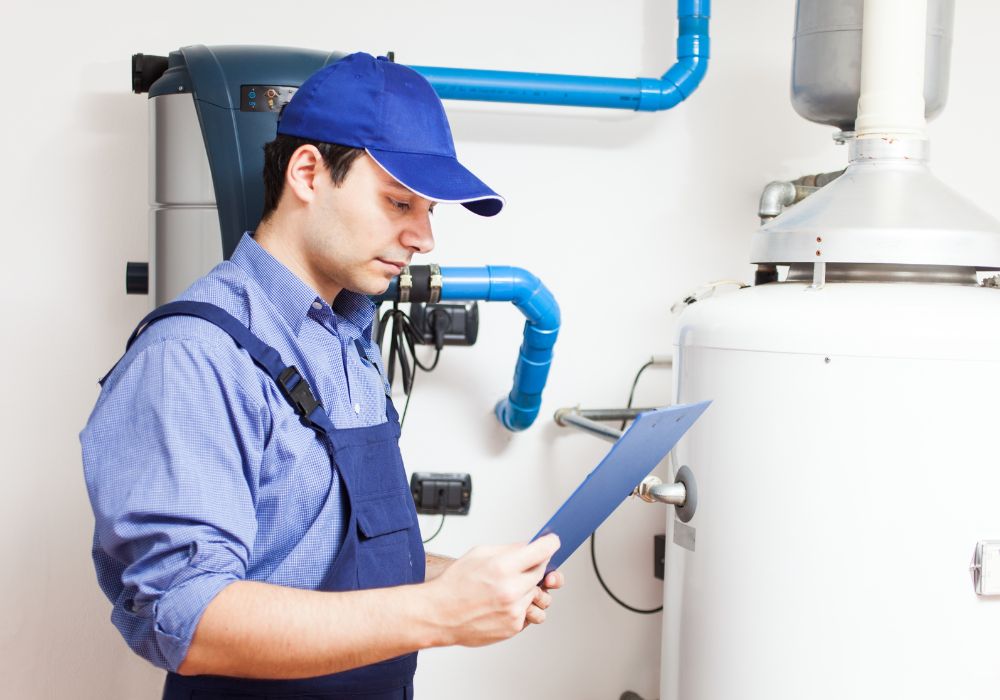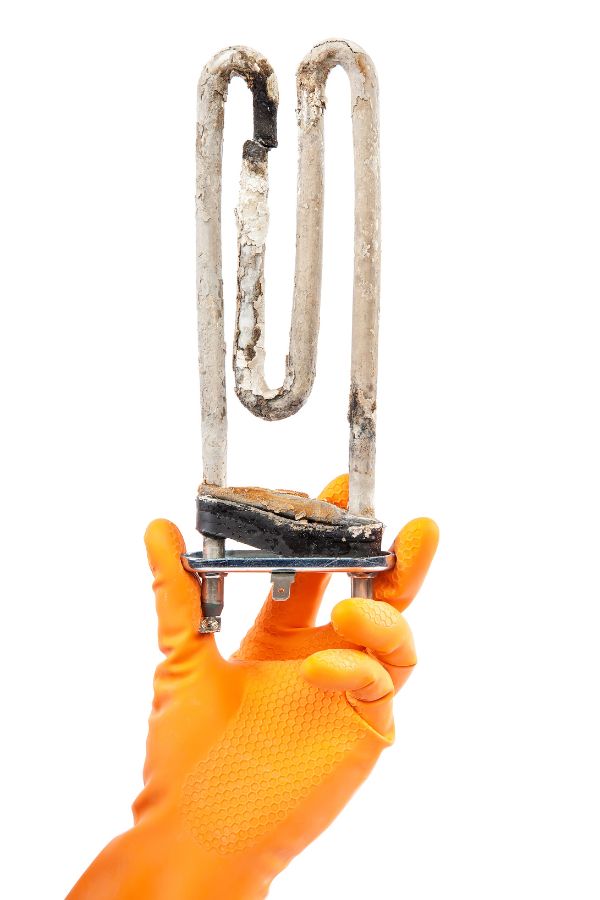No one wants to be in a situation where they don’t have hot water coming from their kitchen sink.
Below are some suggestions on how to fix this problem or prevent it from occurring.
No hot water on the kitchen sink indicates a clog between the water heater and the faucet. The cause may be as basic as line blockages and rust in the heater.
At the same time, failing heating elements and cartridge issues can add to the water flow barrier. In the meantime, you might want to check other faucets throughout the house.
What Causes Hot Water To Stop Working?

Your hot water stops working mainly because of a clog between the water heater and the faucet. Rust in the heater or clogs in the lines is two possible causes.
In addition, issues with failing heating elements or cartridges might obstruct water flow.
Furthermore, you can locate the blockage in the hot supply or on the hot side of the valve.
If your sink has two separate water sources, you need to replace the filter for the hot water. This part of the faucet is also known as a spout tip or Aerator. You can locate it at the very tip of the faucet.
It could be major work when using only one faucet for cold and hot water supplies. It indicates that a blockage has occurred in the hot water line.
If that doesn’t work, you must hire a professional plumber. You can fix a leaking faucet if the issue lies within the fixture itself. This, of course, varies from model to model.
But first, we’ll identify the 4 major causes and provide solutions.
1. Line Blockages
Check for clogs in the pipes if your kitchen sink never gets hot water. Turn off the cold-water supply and check for leaks. This would require you to go under the sink.
- To fix this, take out the aerator. Then repeatedly turn the supply valve on and off to check if anything comes out.
- If this is not the case, you must turn off the supply valve. Next is to make sure it stays off before disconnecting the supply line.
- Position a bucket beneath the valve, don a rubber glove, and use your hand to control the water flow. Turn the valve open and see whether you get a good flow. It’s going to heat up, so be careful.
- To restore proper flow, disassemble the faucet and flush the parts. Removing the cartridges and slightly opening the supply valves is usually sufficient. In the event that you cannot remove the clog, you will need to replace it.
When you turn on the hot water intake, the pressure will push whatever is clogging the pipe out of the spout. Reassembling your kitchen sink after removing blockers should restore normal hot water flow.
2. Rust In The Heater
Anode rod corrosion is a major contributor to a rusting water valve in your kitchen sink.
When this happens, the water tank can accommodate the magnesium or aluminum rod. It’s also possible that the valve won’t function properly if the heater is old.

If your water heater sits too long, the hot water will corrode the internal lining. As a result, it will eventually rust to the point where it won’t heat water effectively anymore.
- You should check and change or replace anode rods annually to prevent this problem.
- Then, periodically remove the silt in the kitchen valve by attaching a hose to the drain. Next is to release the pressure.
- Because of the sediment buildup, you may need to remove the valve. Then clean the opening if you have not used the valve for a long time.
- If the problem persists, remove the lowest element. Then maintain the valve with a shop vac or replace the heater.
Taking care of these issues should get your water heater back up and running in good working order.
3. Failing Heating Elements

In most cases, the elements of a water heater will either burn out or get so coated in mineral scale. As a result, they can no longer function as heat sources.
An electric water heater element is a resistive heating element wrapped in metal. When that happens, the thermostat usually trips because of the overload.
To start, empty the water from the water heater’s tank. You could use tank water to try to change the elements.
- To fix this problem, disconnect the element’s wiring. Recall how it was so you could restore it to its original state.
- Next is to use the appropriate wrench to take out the part. After installing the replacement part, tighten it using the appropriate wrench.
- Then proceed to reconnect the cables. Verify the connections are secure and the wiring is accurate.
- Activate the water supply and allow it to fill the tank. Turn the hot water tap on and keep it open until no more air comes out and only water flows.
- Finally, activate the electric heater’s circuit breaker.
Electric water heaters can feature either one or two heating components. To make a switch of the upper element, drain enough water to lower the level below the element.
4. Cartridge Issues
As time passes, junk builds up inside the cartridge of the sink’s faucet. As a result, this makes it impossible for water to flow freely.
Hot water won’t come out of the faucet if the obstruction is large enough to hinder the water flow. This can also lead to faucet cartridge corrosion or wear and tear. If the leak is in the hot water supply, it will also affect your energy costs.
Generally, the main cause of cartridge failure is the clogs within its channels. It can also be the dried-up rubber O ring inside the faucet or valve.
- Before you begin, make sure you turn off the water valve.
- Then turn off the water supply. You may want to avoid a major water leak, so knowing what’s happening inside the pipes is essential.
- If you want to check the temperature of the pipes under the sink, you can do so once you turn it off.
- To fix the cartridge, remove the faucet, take out the cartridge, and put in a new one.
- Replacement cartridges should be of the same size and brand as the original.
- Then install a new faucet and activate the water to check the system’s functionality.
Don’t forget to close the water valve beneath the sink and reassemble the faucet. Overall, this should fix the hot water issue at your kitchen sink.
What To Do When Hot Water Stops Working?
You may need to check the circuit breaker if your hot water stops working. Then do a water heater reset. The next step is to inspect the area around your tank for water leaks.
Next, examine the water heater’s storage tanks. Inspect the area and drain the water. Lastly, remember to recheck if the pilot light is on.
Step 1. Inspect The Circuit Breaker
It’s possible that the water heater isn’t getting power if it isn’t producing hot water. A tripped limit switch or broken heating element could be the root of the problem.
Turn it back on if it has tripped. Suppose it hasn’t; try turning it off and back on again.
Step 2. Reset Your Water Heater
First, turn off the breaker at the service panel to do this. Then remove the access panel, insulation, and plastic safety guard.
Remember to press the red reset button, and last, reconnect everything. If that doesn’t work, you might have to check and replace the system’s heating element.
Step 3. Investigate The Area For Signs Of Leaks
Check to see that all of the pipes and hoses leading to it are in good working order. Look for water on the ground around your water heater to confirm the presence of a leak.
Step 4. Inspect And Drain
At least once a year, open the drain petcock at the base of the water heater tank and let all the water drain out. As a result, the sediment and mineral buildup at the water heater’s base will be greatly reduced.
Step 5. Verify if Pilot Light Is On
Verify the safety of the panel once more. A temperature control dial with a Pilot Light notched into it. Push the ignitor and keep the knob turned to “Pilot.”
Why Does It Take So Long To Get Hot Water To My Kitchen Sink?
In most cases, the distance between the water heater and the fixture is a major factor. Because of this, the hot water takes so long to reach the faucet.
The farther away a fixture is from the water heater, the longer it takes hot water to reach it.
To maintain the same temperature as the tank, the water in the pipe must travel a distance of about 1.5 times its volume.
Two options are available if you want hot water at your sink immediately.
(1) To have hot water available immediately, many plumbers install a recirculating pump. They usually install it at the end of the line and route water back into the water heater.
(2) Put in a hot water return system. If the kitchen is between the water heater and the bathroom, you can open the hot water valves to speed it up. If you remove the aerator, you’ll get more flow, which will heat it faster.
Why Is My Hot Water Pressure Low In My Kitchen Sink Only?
Your kitchen sink’s hot water pressure is low because of the faucet. Luckily, this is easy to fix.
Some faucets have washers or disks that can break or make it hard to control. If that happens, you probably won’t be able to turn that part off.
- First, unscrew the small part at the very end of the spigot. Then take it off, and clean it out. This will instantly fix your water pressure and flow rate.
- You can also try shutting off the isolation valves under your sink one at a time and testing the water flow.
- After these steps, you should better understand which part of your system is causing the problem.
- Then you can take it apart to see if something is stuck in the pipes or valves.
Above all, you should call a plumber if you have trouble with your kitchen’s low hot water pressure. Getting immediate help may be necessary if a water leak is particularly severe.









